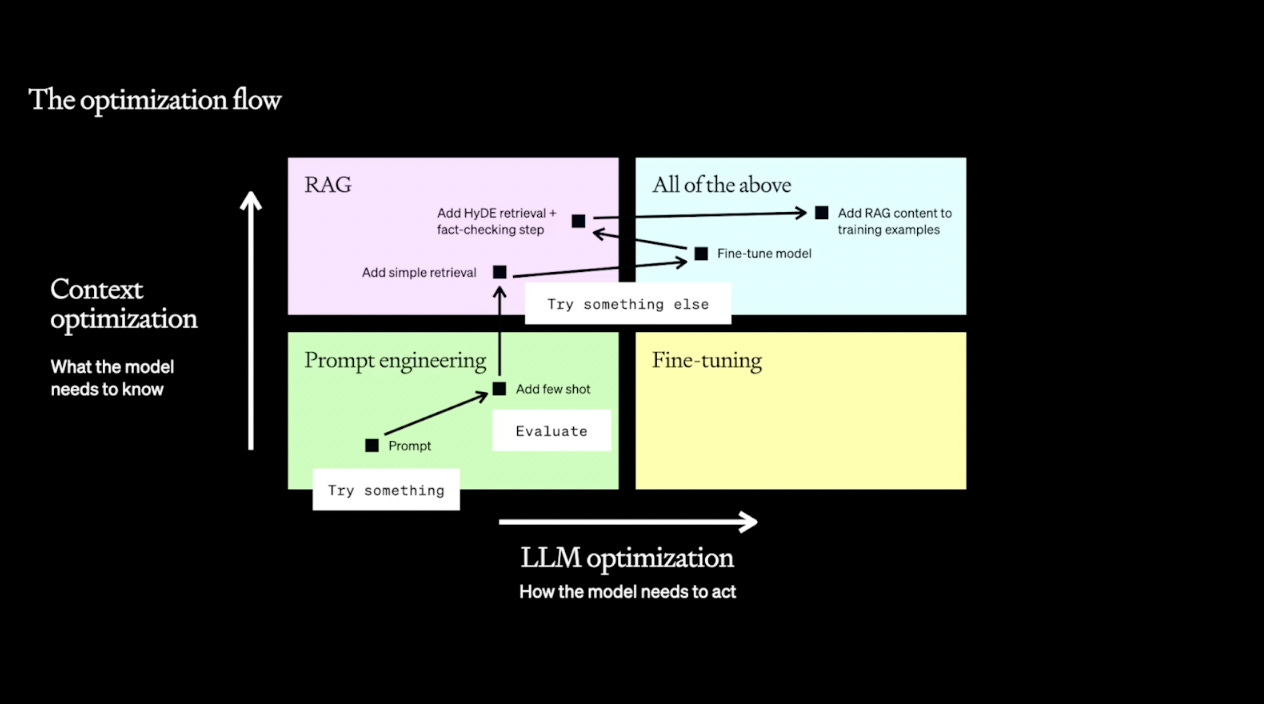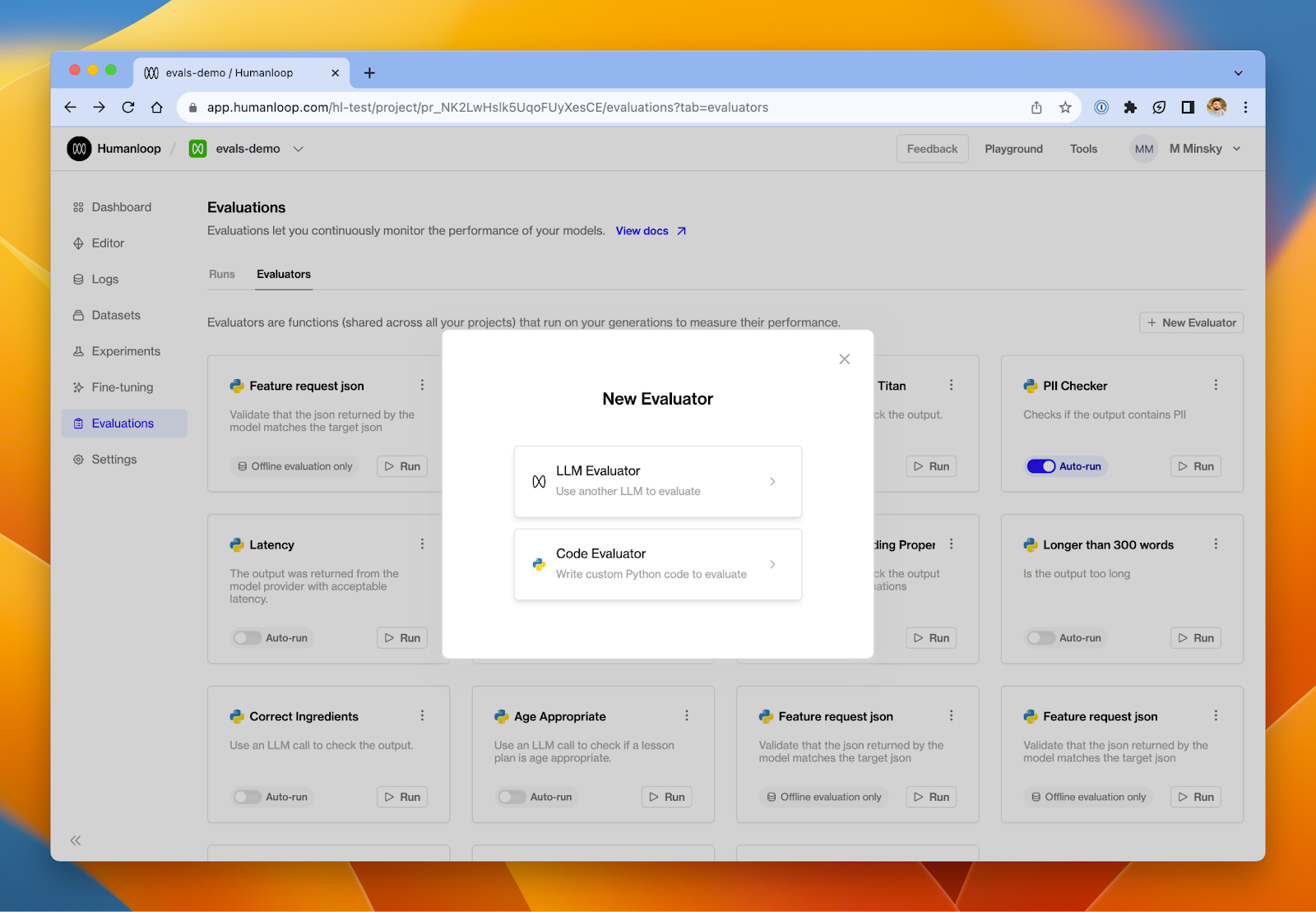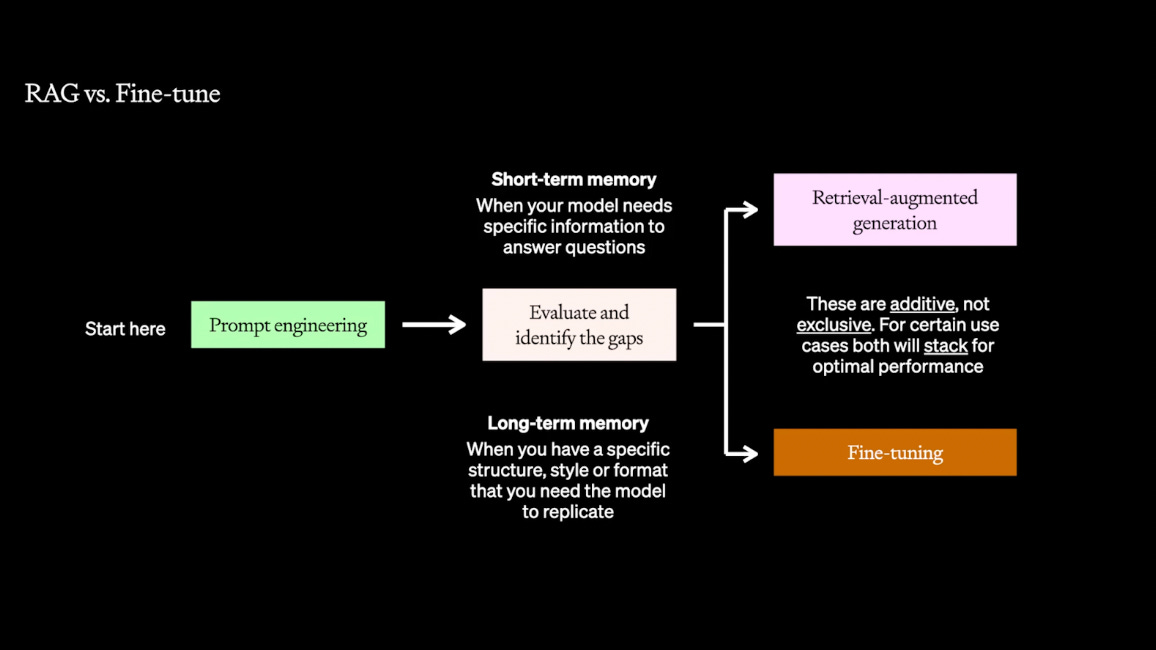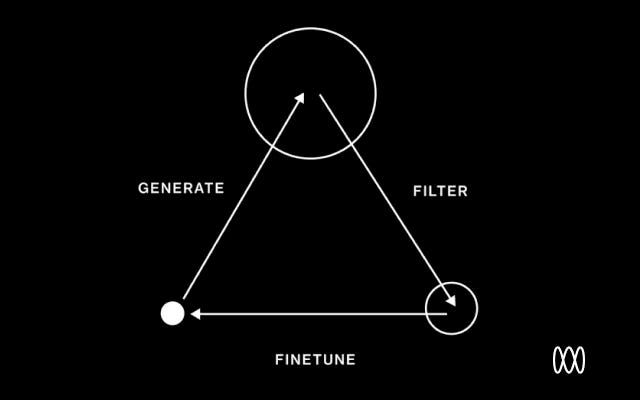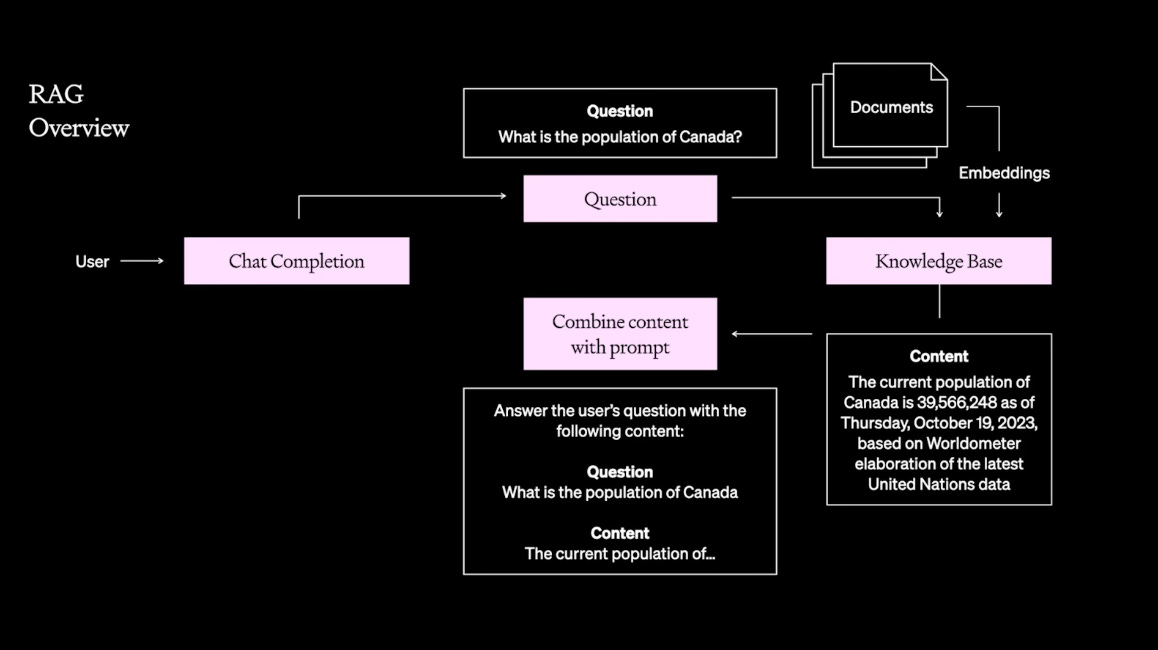📝 Guest Post: How to Maximize LLM Performance*
Was this email forwarded to you? Sign up here In this post, Jordan Burgess, co-founder and Chief Product Officer at Humanloop, discusses the techniques for going from an initial demo to a robust production-ready application and explain how tools like Humanloop can help you get there. He covers best practices in prompt engineering, retrieval-augmented generation (RAG) and fine-tuning. Let’s dive in! You need to optimize your LLMs to get from prototype to productionCreating an impressive AI demo that works part of the time can be easy, but to get to production, you’re always going to need to iterate and improve your LLM application’s performance. The three most common techniques for improving your application are prompt engineering, retrieval augmented generation (RAG) and fine-tuning.
A common mistake is to think that this is a linear process and should be done in that order! But RAG and fine-tuning solve different problems and the usual path is more iterative, alternating between all three techniques depending on what’s the limiting factor to your application’s performance. Humanloop helps you to approach this process systematically. You should iteratively ask yourself two questions:
But first, you need evals“If you can’t measure it, you can’t improve it.” — Peter Drucker The most crucial step in the optimization process is setting up a solid evaluation framework. Without a clear understanding of your model's performance, it's impossible to tell if you’re making progress. The goal of evaluation is not just to identify where the model falls short, but also to uncover actionable insights that guide your optimization strategy. Whether you're refining prompts, tweaking RAG, or fine-tuning the model, evals should help you know what to try next. Here are some of the most common evaluation techniques:
LLMOps platforms like Humanloop offer an integrated process for evaluating your prompts with the tools you need for prompt engineering and fine-tuning. For RAG specifically, information retrieval based scoring can be applicable. Open source eval frameworks like RAGAS can help evaluate retrieval-based scoring. Do prompt engineering first (and last!)Prompt engineering should nearly always be the first thing you explore in optimizing your LLM performance. In fact, it should be one of the things you also re-explore after RAG, fine-tuning, or other advanced techniques, given how core the prompt is to LLM generations. For more guidance, we recommend starting with Prompt Engineering 101 and the very through Prompt Engineering Guide. Even with prompt engineering alone, you can make sufficient inroads on the two axes of optimization. If the issue is with the output, you can constrain the response to be JSON, or to follow a specific format with tool calling. You can also add in examples of the task being performed ('few-shot learning') which can help the model understand the task better. If the issue is with context, you can prompt-stuff (technical term) with all the relevant and maybe-relevant context it needs. The main limitation is the size of the context window and what you’re willing to pay in cost and latency. Evaluate and version your prompts to make sure you’re making progressWhen prompt engineering, keeping track of changes to your prompts and parameters is key. Every adjustment should be recorded and evaluated systematically, helping you understand which changes improve performance and which don’t. At this stage it’s helpful to have a specialized prompt development tool like Humanloop. A prompt editor that is paired with an evaluation framework can systematize iteration and allow engineers to more easily collaborate with domain experts. After prompt engineering, you should identify where the largest gaps are. From this, you can decide whether to explore RAG or fine-tuning. Fine-tune to optimize performance, improve efficiency and become defensibleFine-tuning is continuing the training process of the LLM on a smaller, domain-specific dataset. This can significantly improve the model's performance on specialized tasks by adjusting the model's parameters themselves, rather than just changing the prompt. Think of fine-tuning like compiling code. It’s an optimization step for something that’s mostly already working One of the biggest challenges with fine-tuning is having the right dataset and curating it. This is an area where having the right infrastructure can be very helpful. A very common workflow is to use your evaluation data to filter your production logs to find the best performing examples and then fine-tune on that data. This process can often be repeated multiple times with continued improvement. Tools like Humanloop help here because they allow you to log user data from your production applications alongside evaluation. Why fine-tune?There are two main benefits to fine-tuning: Improving model performance on a specific taskFine-tuning means you can pack in more examples. You can fine-tune on millions of tokens, whereas few-shot learning prompts are limited to 10s of thousands of tokens, depending on the context size. A fine-tuned model may lose some of its generality, but for its specific task, you should expect better performance. Improving model efficiencyEfficiency for LLM applications means lower latency and reduced costs. This benefit is achieved in two ways. By specializing the model, you can use a much smaller model. Additionally, as you train only on input-output pairs, not the full prompt with any of its prompt engineering tricks and tips, you can discard the examples or instructions. This can further improve latency and cost. Best practices for fine-tuningFor fine-tuning to work best you should start with a clear goal and a relevant, high-quality dataset. It's crucial to fine-tune with data that exemplifies the type of output you need. Moreover, iterative testing is vital – start with small, incremental changes and evaluate the results before proceeding further. It matters a lot what you fine-tune on! Use Retrieval-Augmented Generation (RAG) if the issues are due to contextWhen you're dealing with LLMs, sometimes the challenge isn't just about how the model generates responses, but about what context it has access to. The models have been trained on mostly public domain content from the web; not your company's private data, nor the latest information from your industry. This is where Retrieval-Augmented Generation (RAG) comes into play. It's combining the capabilities of LLMs with the context of external data sources. Setting up RAGThe first thing to do is to demonstrate performance with some handpicked few-shot examples. After which you may wish to operationalize this with a system for picking out those examples. RAG can be as simple as creating a prompt template and inserting dynamic content fetched from a database. As LLM applications often work with natural language, it’s very common to use semantic search on a vector database, such as Qdrant, Chroma and Pinecone. Tool calling is a way to use the LLM to create the structured output necessary to directly call systems like traditional SQL databases. And Prompt Tools enable you to conveniently hook up resources into your prompts with having to build any data pipelines. However, RAG is rarely a plug-and-play solution. Implementing RAG requires careful consideration of the sources you allow the model to access, as well as how you integrate this data into your LLM requests. It's about striking the right balance between providing enough context to enhance the model's responses while ensuring that the information it retrieves is reliable and relevant. Combine all the techniques for optimal resultsRemember, nearly all these techniques are additive. Fine-tuning refines the model's understanding of a task, making it adept at delivering the right kind of output. By pairing it with RAG, the model not only knows what to say but also has the appropriate information to draw from. This dual approach leverages the strengths of both fine-tuning (for task-specific performance) and RAG (for dynamic, context-rich information retrieval), leading to a more performant LLM application. Prompt engineering is always the first step in the optimization process. By starting with well-crafted prompts, you understand what's the inherent capability of the model for your task – and prompt engineering may be all that you need! ConclusionFor those building applications that rely on LLMs, the techniques shown here are crucial for getting the most out of this transformational technology. Understanding and effectively applying prompt engineering, RAG, and fine-tuning are key to transitioning from a promising prototype to a robust production-ready model. The two axes of optimization – what the model needs to know and how the model needs to act – provide a roadmap for your efforts. A solid evaluation framework and a robust LLMOps workflow are the compasses that guide you, helping you to measure, refine, and iterate on your models. I encourage readers to delve deeper into these methods and experiment with them in their LLM applications for optimal results. If you’re interested in whether an integrated platform like Humanloop can provide the LLMOps infrastructure you need to track, tune, and continually improve your models, please request a demo. *This post was written by Jordan Burgess, co-founder and Chief Product Officer at Humanloop, specially for TheSequence. We thank Humanloop for their insights and ongoing support of TheSequence.You’re on the free list for TheSequence Scope and TheSequence Chat. For the full experience, become a paying subscriber to TheSequence Edge. Trusted by thousands of subscribers from the leading AI labs and universities. |
Older messages
Meet Zephyr: How Hugging Face's Instruction Fine Tuned LLM Outperformed Models 10 Times Its Size
Thursday, December 7, 2023
A fine-tuned version of Mistral, Zephyr applied some very clever techniques that led it to outperform LLaMA 70B and other much larger models.
Edge 349: Reinforcement Learning with AI Feedback
Tuesday, December 5, 2023
One of the most promising techniques that uses feedback from AI agents to fine tune foundation models.
📹 [Webinar] Building a Real-Time Fraud Detection System at Signifyd
Monday, December 4, 2023
Fraudsters are always evolving their tactics, such as using AI and LLMs, to bypass detection. To combat fraud, Signifyd, an e-commerce fraud detection platform, uses ML to make instantaneous decisions
AWS’ Generative AI Strategy Starts to Take Shape and Looks a Lot Like Microsoft’s
Sunday, December 3, 2023
AWS re:Invent was innundated with generative AI announcements.
📺 [Live Webinar] From Dream to Stream: Scaling ML Engineering at Flo Health
Friday, December 1, 2023
At Flo Health, the maker of the most popular women's health app in the world, ML is an engineering discipline — and as a quickly growing company, their ML team faces significant operational
You Might Also Like
Import AI 399: 1,000 samples to make a reasoning model; DeepSeek proliferation; Apple's self-driving car simulator
Friday, February 14, 2025
What came before the golem? ͏ ͏ ͏ ͏ ͏ ͏ ͏ ͏ ͏ ͏ ͏ ͏ ͏ ͏ ͏ ͏ ͏ ͏ ͏ ͏ ͏ ͏ ͏ ͏ ͏ ͏ ͏ ͏ ͏ ͏ ͏ ͏ ͏ ͏ ͏ ͏ ͏ ͏ ͏ ͏ ͏ ͏ ͏ ͏ ͏ ͏ ͏ ͏ ͏ ͏ ͏ ͏ ͏ ͏ ͏ ͏ ͏ ͏ ͏ ͏ ͏ ͏ ͏ ͏ ͏ ͏ ͏ ͏ ͏ ͏ ͏ ͏ ͏ ͏ ͏ ͏ ͏ ͏ ͏ ͏ ͏ ͏ ͏ ͏ ͏ ͏ ͏
Defining Your Paranoia Level: Navigating Change Without the Overkill
Friday, February 14, 2025
We've all been there: trying to learn something new, only to find our old habits holding us back. We discussed today how our gut feelings about solving problems can sometimes be our own worst enemy
5 ways AI can help with taxes 🪄
Friday, February 14, 2025
Remotely control an iPhone; 💸 50+ early Presidents' Day deals -- ZDNET ZDNET Tech Today - US February 10, 2025 5 ways AI can help you with your taxes (and what not to use it for) 5 ways AI can help
Recurring Automations + Secret Updates
Friday, February 14, 2025
Smarter automations, better templates, and hidden updates to explore 👀 ͏ ͏ ͏ ͏ ͏ ͏ ͏ ͏ ͏ ͏ ͏ ͏ ͏ ͏ ͏ ͏ ͏ ͏ ͏ ͏ ͏ ͏ ͏ ͏ ͏ ͏ ͏ ͏ ͏ ͏ ͏ ͏ ͏ ͏ ͏ ͏ ͏ ͏ ͏ ͏ ͏ ͏ ͏ ͏ ͏ ͏ ͏ ͏ ͏ ͏ ͏ ͏ ͏ ͏ ͏ ͏ ͏ ͏ ͏ ͏ ͏ ͏ ͏ ͏ ͏
The First Provable AI-Proof Game: Introducing Butterfly Wings 4
Friday, February 14, 2025
Top Tech Content sent at Noon! Boost Your Article on HackerNoon for $159.99! Read this email in your browser How are you, @newsletterest1? undefined The Market Today #01 Instagram (Meta) 714.52 -0.32%
GCP Newsletter #437
Friday, February 14, 2025
Welcome to issue #437 February 10th, 2025 News BigQuery Cloud Marketplace Official Blog Partners BigQuery datasets now available on Google Cloud Marketplace - Google Cloud Marketplace now offers
Charted | The 1%'s Share of U.S. Wealth Over Time (1989-2024) 💰
Friday, February 14, 2025
Discover how the share of US wealth held by the top 1% has evolved from 1989 to 2024 in this infographic. View Online | Subscribe | Download Our App Download our app to see thousands of new charts from
The Great Social Media Diaspora & Tapestry is here
Friday, February 14, 2025
Apple introduces new app called 'Apple Invites', The Iconfactory launches Tapestry, beyond the traditional portfolio, and more in this week's issue of Creativerly. Creativerly The Great
Daily Coding Problem: Problem #1689 [Medium]
Friday, February 14, 2025
Daily Coding Problem Good morning! Here's your coding interview problem for today. This problem was asked by Google. Given a linked list, sort it in O(n log n) time and constant space. For example,
📧 Stop Conflating CQRS and MediatR
Friday, February 14, 2025
Stop Conflating CQRS and MediatR Read on: my website / Read time: 4 minutes The .NET Weekly is brought to you by: Step right up to the Generative AI Use Cases Repository! See how MongoDB powers your

